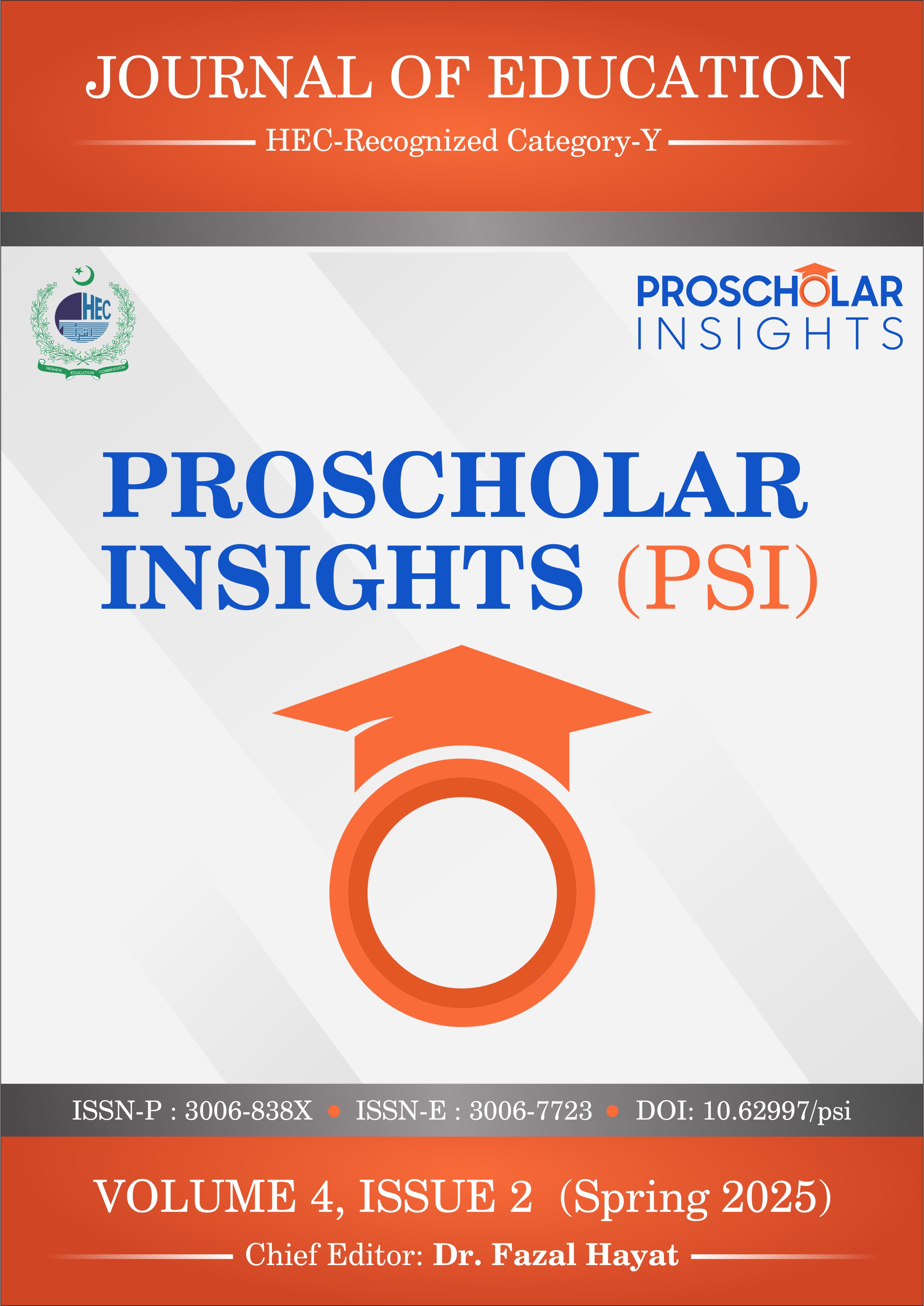Knowledge, Attitude and Practice (KAP) Study of University Students about Cyberbullying in Multan
DOI:
https://doi.org/10.55737/psi.2025b-42085Keywords:
Cyberbullying, Female Students, Knowledge, Attitude and Practices, Women University MultanAbstract
Cyberbullying is defined as the use of digital technology to harass, threaten, or embarrass another person repeatedly. It involves the misuse of social media platforms to harass those people who are unable to defend themselves. A study to assess the knowledge, Attitude and practices about cyberbullying done among female university students of the faculty of social sciences at Women's University, Multan. A cross-sectional study was conducted on a sample of 310 female students. Data was collected with the use of a structured self-administered questionnaire. The questionnaire includes some demographic questions and ten questions to assess the knowledge of students about cyberbullying, ten questions to assess the practices, and ten questions related to the attitude of the students towards cyberbullying. Statistical Package of Social Sciences (SPSS) is used to see the Chi-Square and correlation. Results showed that the majority of the students have a higher level of knowledge about cyberbullying and participate in preventive activities, and over half of the students express a negative attitude toward cyberbullying. The study highlights that there is a need for awareness programs, digital security, and policies to empower students to wisely handle cyberbullying incidents.
References
Al-Alosi, H. (2017). Cyber-violence: Digital abuse in the context of domestic violence. The University of New South Wales Law Journal, 40(4). https://doi.org/10.53637/dhuv6093
Arıcak, O. T. (2009). Psychiatric symptomatology as a predictor of cyberbullying among university students. Eurasian Journal of Educational Research (EJER), (34).
Balakrishnan, V. (2015). Cyberbullying among young adults in Malaysia: The roles of gender, age and Internet frequency. Computers in Human Behavior, 46, 149–157. https://doi.org/10.1016/j.chb.2015.01.021
Bashir, S., Naseer, F., Karim, H., Farooq, K., & Sultana, B. B. (2021). Social Media Improving The Quality Education: A Case Study Of University Of Balochistan, Quetta. Ilkogretim Online, 20(2), 1886-1905. http://dx.doi.org/10.17051/ilkonline.2021.02.203
Gritzalis, S. (2004). Enhancing Web privacy and anonymity in the digital era. Information Management & Computer Security, 12(3), 255–287. https://doi.org/10.1108/09685220410542615
Heffernan, T., & Bosetti, L. (2021). Incivility: The new type of bullying in higher education. Cambridge Journal of Education, 51(5), 641-652.
Hinduja, S., & Patchin, J. W. (2011). Cyberbullying: A review of the legal issues facing educators. Preventing school failure: Alternative education for children and youth, 55(2), 71-78. https://doi.org/10.1080/1045988X.2011.539433
Hossain, M. A., & Yasmin, F. (2022). Emergency online teaching-learning model in the context of higher-level education due to the COVID-19 pandemic. J Soc Hum Educ, 2(4), 327-41. https://doi.org/10.35912/jshe.v2i4.1109
Khine, A. T., Saw, Y. M., Htut, Z. Y., Khaing, C. T., Soe, H. Z., Swe, K. K., ... & Hamajima, N. (2020). Assessing risk factors and impact of cyberbullying victimization among university students in Myanmar: A cross-sectional study. PloS one, 15(1), e0227051. https://doi.org/10.1371/journal.pone.0227051
Kibe, L., Kwanya, T., Kogos, A., Ogolla, E., & Onsare, C. (2022). Types of Cyberbullying Experienced on Facebook by Undergraduate Students in Kenyan Universities. Journal of Cyberspace Studies, 6(2), 149-182. https://nbn-resolving.org/urn:nbn:de:0168-ssoar-86251-1
Kowalski, R. M., Giumetti, G. W., Schroeder, A. N., & Lattanner, M. R. (2014). Bullying in the digital age: a critical review and meta-analysis of cyberbullying research among youth. Psychological Bulletin, 140(4), 1073–1137. https://doi.org/10.1037/a0035618
Lee, Y. C., & Wu, W.-L. (2018). Factors in cyber bullying: the attitude-social influence-efficacy model. Anales de Psicología, 34(2), 324. https://doi.org/10.6018/analesps.34.2.295411
Merrick, J. (2018). Cyberbullying in colleges and universities: A survey of student experiences and attitudes about cyberbullying. International Journal of Child and Adolescent Health, 11(1), 73-97.
Mishna, F., Cook, C., Gadalla, T., Daciuk, J., & Solomon, S. (2010). Cyber bullying behaviors among middle and high school students. The American Journal of Orthopsychiatry, 80(3), 362–374. https://doi.org/10.1111/j.1939-0025.2010.01040.x
Myers, C.-A., & Cowie, H. (2019). Cyberbullying across the lifespan of education: Issues and interventions from school to university. International Journal of Environmental Research and Public Health, 16(7), 1217. https://doi.org/10.3390/ijerph16071217
Schenk, A. M., & Fremouw, W. J. (2012). Prevalence, psychological impact, and coping of cyberbully victims among college students. Journal of school violence, 11(1), 21-37. https://doi.org/10.1080/15388220.2011.630310
Sennett, J., Finchilescu, G., Gibson, K., & Strauss, R. (2003). Adjustment of black students at a historically white South African university. Educational psychology, 23(1), 107-116. https://doi.org/10.1080/01443410303219
Shariff, S. (2009). Confronting cyber-bullying: What schools need to know to control misconduct and avoid legal consequences. Cambridge University Press.
Shurtleff, B. (2023). Emotion Regulation as a Mediator: Can an Emotion Regulation Intervention Improve Student Emotional Wellness? (Doctoral dissertation, The Chicago School of Professional Psychology).
Vandebosch, H., & Van Cleemput, K. (2009). Cyberbullying among youngsters: profiles of bullies and victims. New Media & Society, 11(8), 1349–1371. https://doi.org/10.1177/1461444809341263
Webber, M. A., & Ovedovitz, A. C. (2018). Cyberbullying among college students: A look at its prevalence at a US Catholic University. International Journal of Educational Methodology, 4(2), 101-107. https://doi.org/10.12973/ijem.4.2.101
Yang, C. C., & Brown, B. B. (2015). Factors involved in associations between Facebook use and college adjustment: Social competence, perceived usefulness, and use patterns. Computers in Human Behavior, 46, 245-253. https://doi.org/10.1016/j.chb.2015.01.015
Zalaquett, C. P., & Chatters, S. J. (2012). Middle school principals' perceptions of middle school counselors' roles and functions. American Secondary Education, 89-103. https://www.jstor.org/stable/43694132











